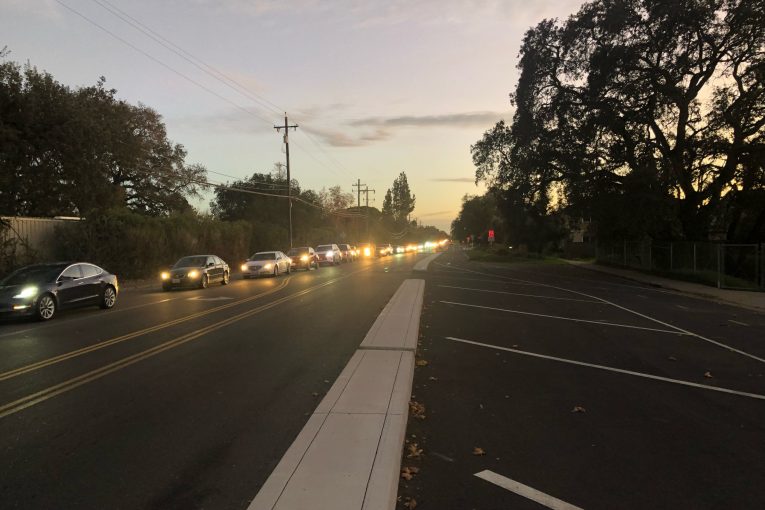

By Peter Jacobsen
Like clockwork, every Thursday and Friday afternoon, Mace Boulevard mysteriously shifts from a quiet street with two vehicles a minute, to a jammed mess.
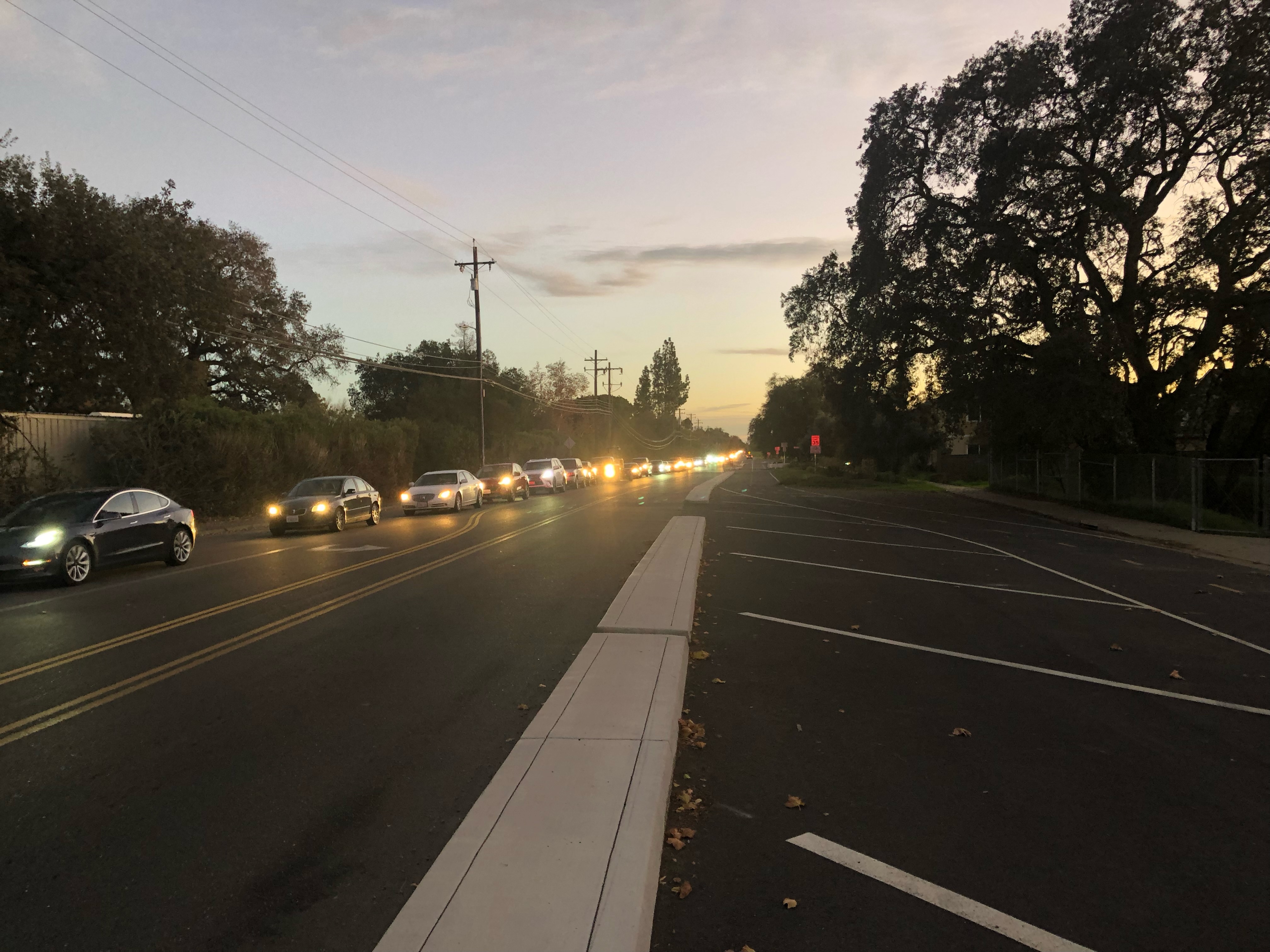
This Tahoe-bound traffic lines up on Mace for over a mile both north and south, waiting to get back on the eastbound freeway.
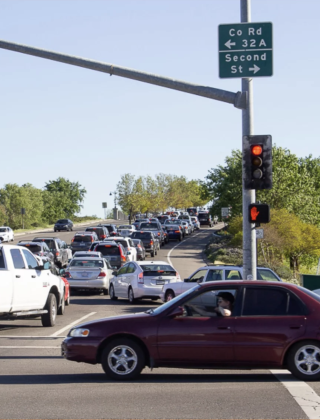
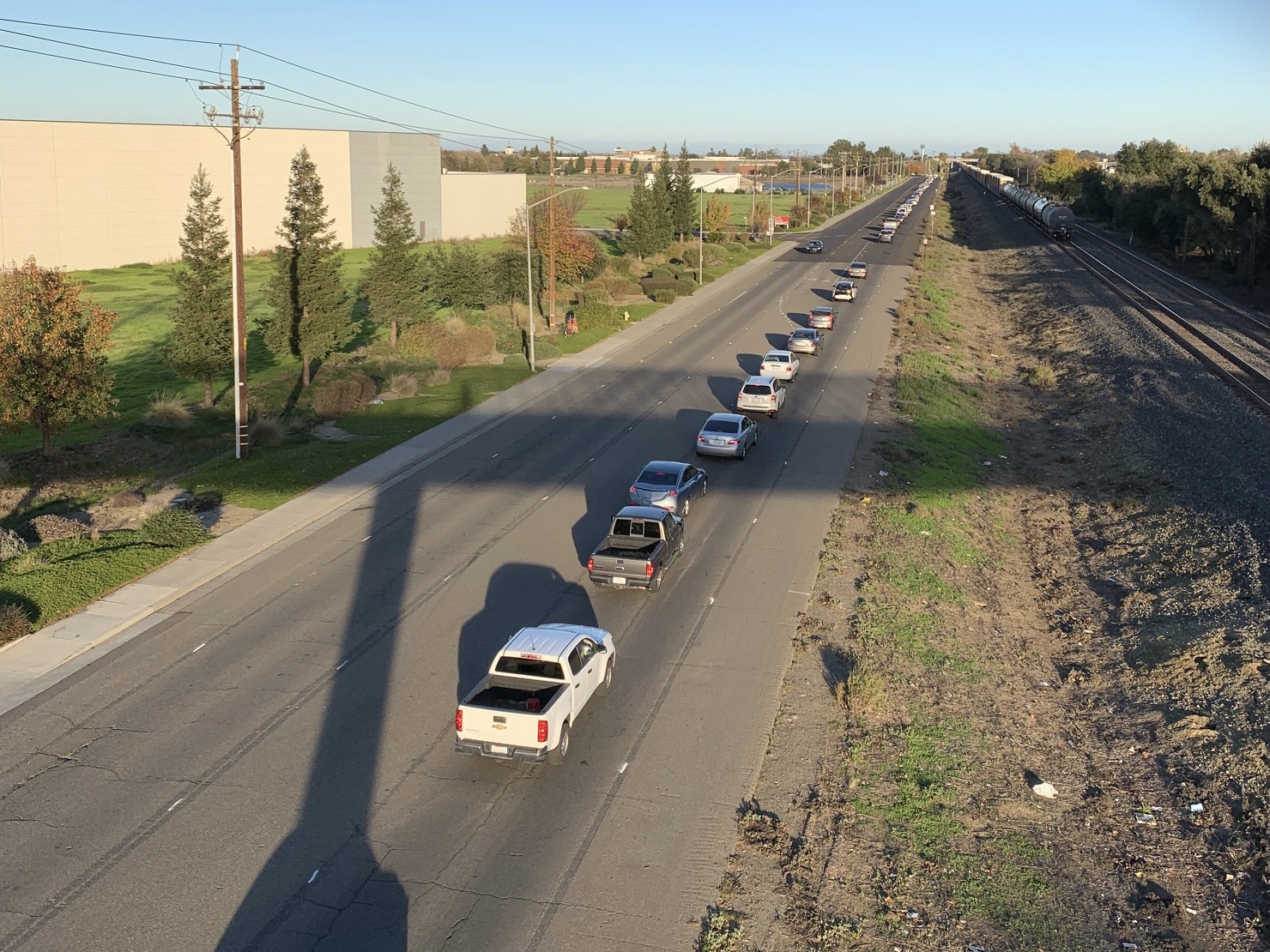
On South Mace, residents can’t even use the street to exit their neighborhood. Davis proposes addressing this congestion by widening South Mace. That will cost $4.5 million, plus another half-million dollars in consultant fees, involve a year of construction hassle, be permanent, and ignores that South Mace was jammed when it previously had four lanes.
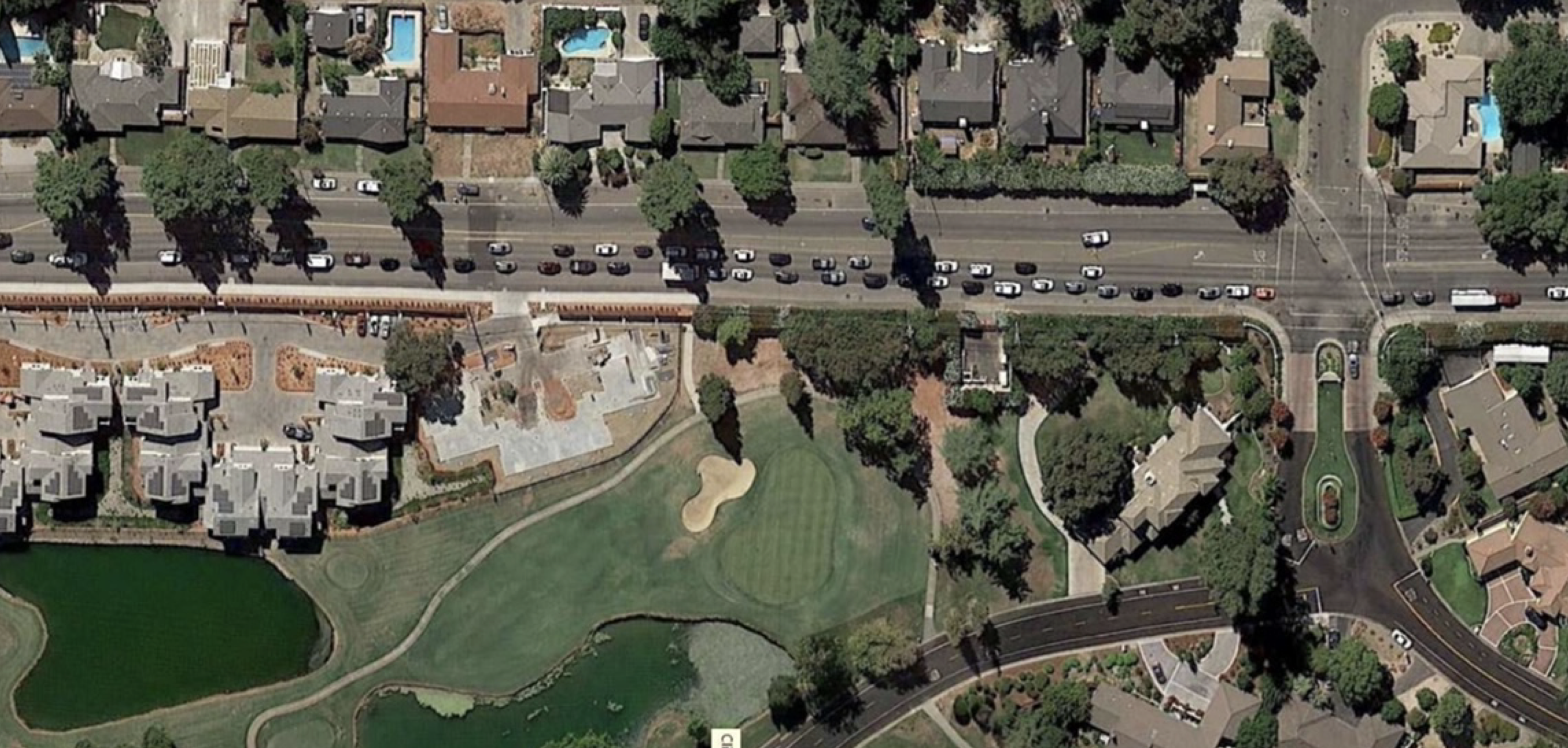
Could closing the unmetered carpool Mace on-ramp lanes remove the traffic from Mace better than more asphalt? I propose Davis work with Caltrans to try two low-cost experiments.
The problem
First, let’s understand that the cause is beyond Davis to fix. Many cities suffer from the “Waze Craze,” which makes driving a game, where the quickest trip time wins.
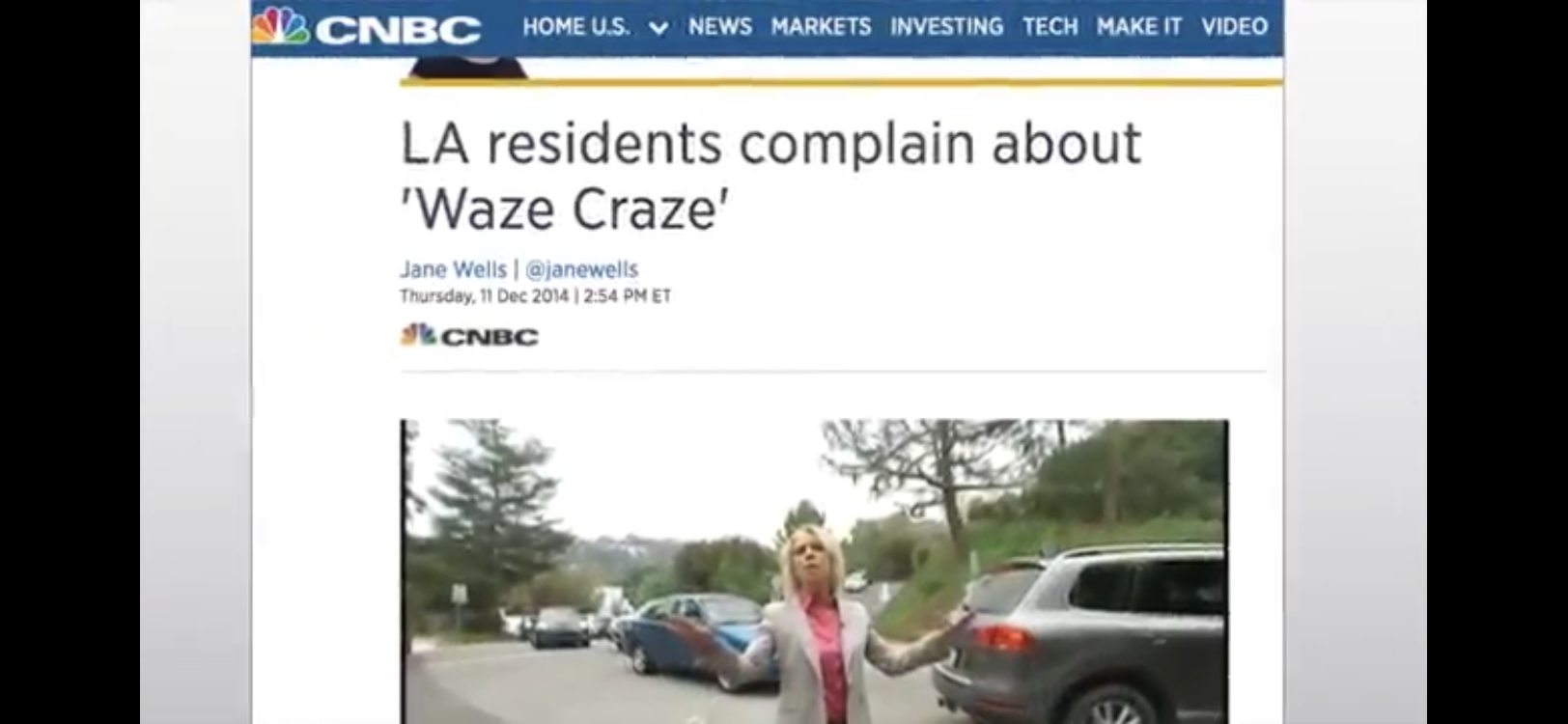
If a driver’s route saves a minute or two, then Waze and the other navigation apps direct hordes to follow. What works for one driver doesn’t work for hundreds. As the shortcut becomes overwhelmed, someone else finds a quicker route, the apps redirect, and the new route gets overwhelmed. Only to repeat again and again.
For Davis to win this game we have to keep that first driver from leaving the freeway and finding a quicker route via Mace.
First fix
Drivers leave eastbound I-80 because it routinely jams up after the 113 interchange. Two miles before the interchange, a lane is gained, and then after the interchange, two more lanes are gained. While you’d be tempted to think more is better, before the Richards exit, all three added lanes are dropped abruptly. All that merging creates turbulence and delay. To avoid that delay, the apps direct traffic to exit and go through Davis. But because the Causeway is the only way across the Yolo Bypass, all that traffic has to return at either the Mace on-ramps (northbound and southbound) or the Chiles on-ramp (Yolo Fruit Stand). Note that every route back to the freeway involves Mace.
Hence, the City needs to ask Caltrans to streamline the freeway by removing these extra lanes.
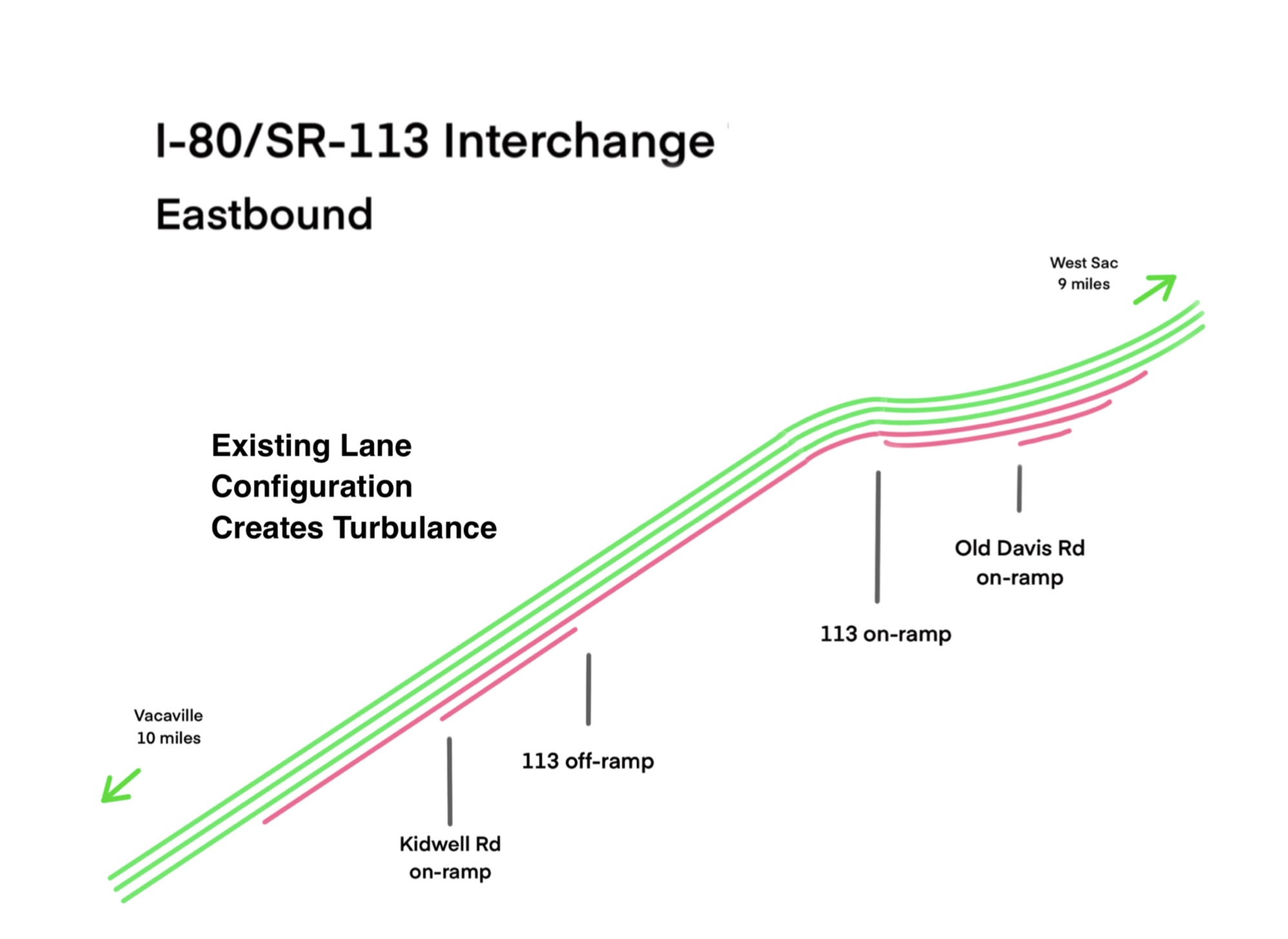
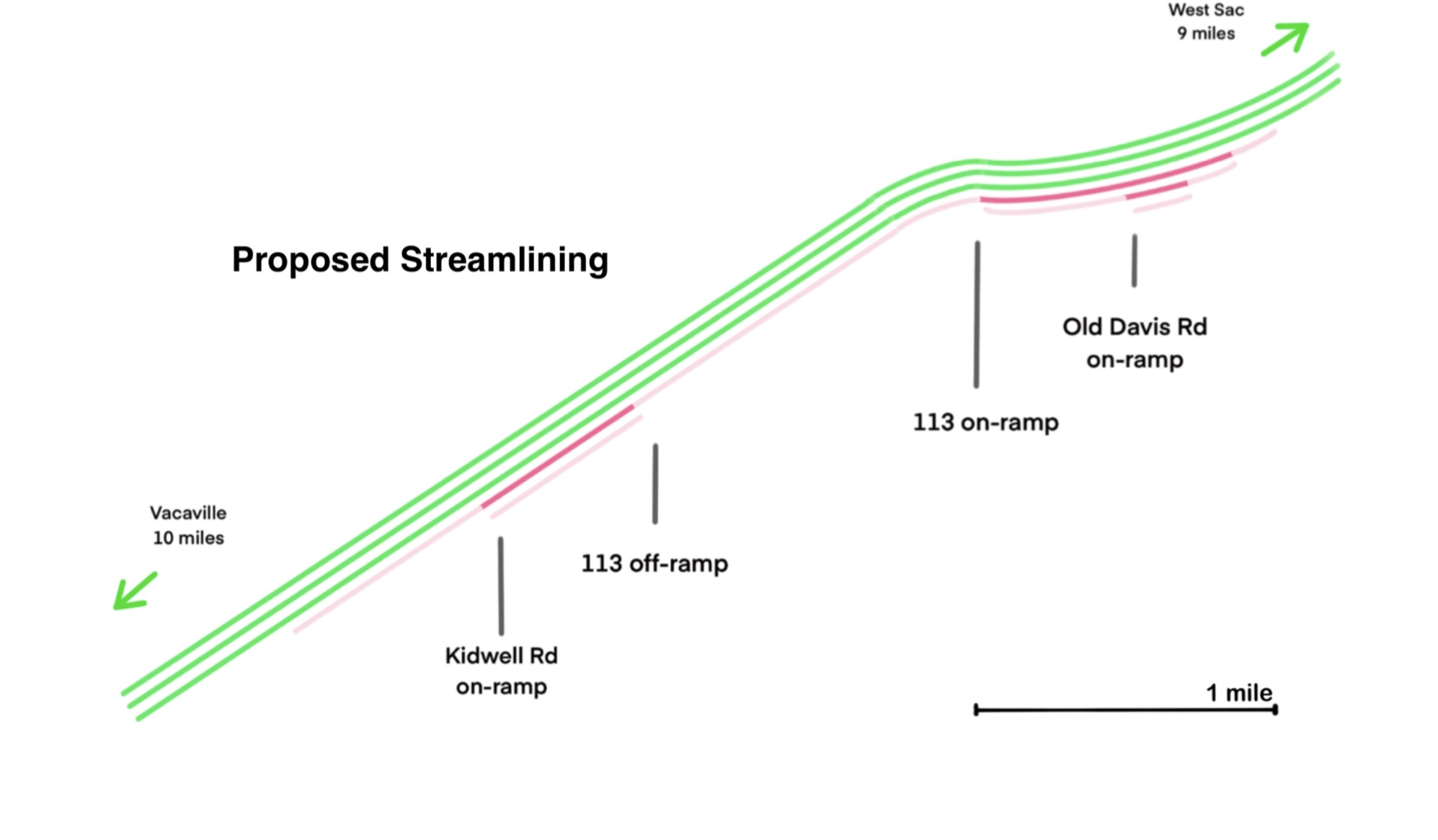 They can experiment with cones. Cheap and fast.
They can experiment with cones. Cheap and fast.
Second fix
The apps report the quickest travel time, and the driver who jumps the queue using the unmetered carpool Mace on-ramp is that quickest driver.
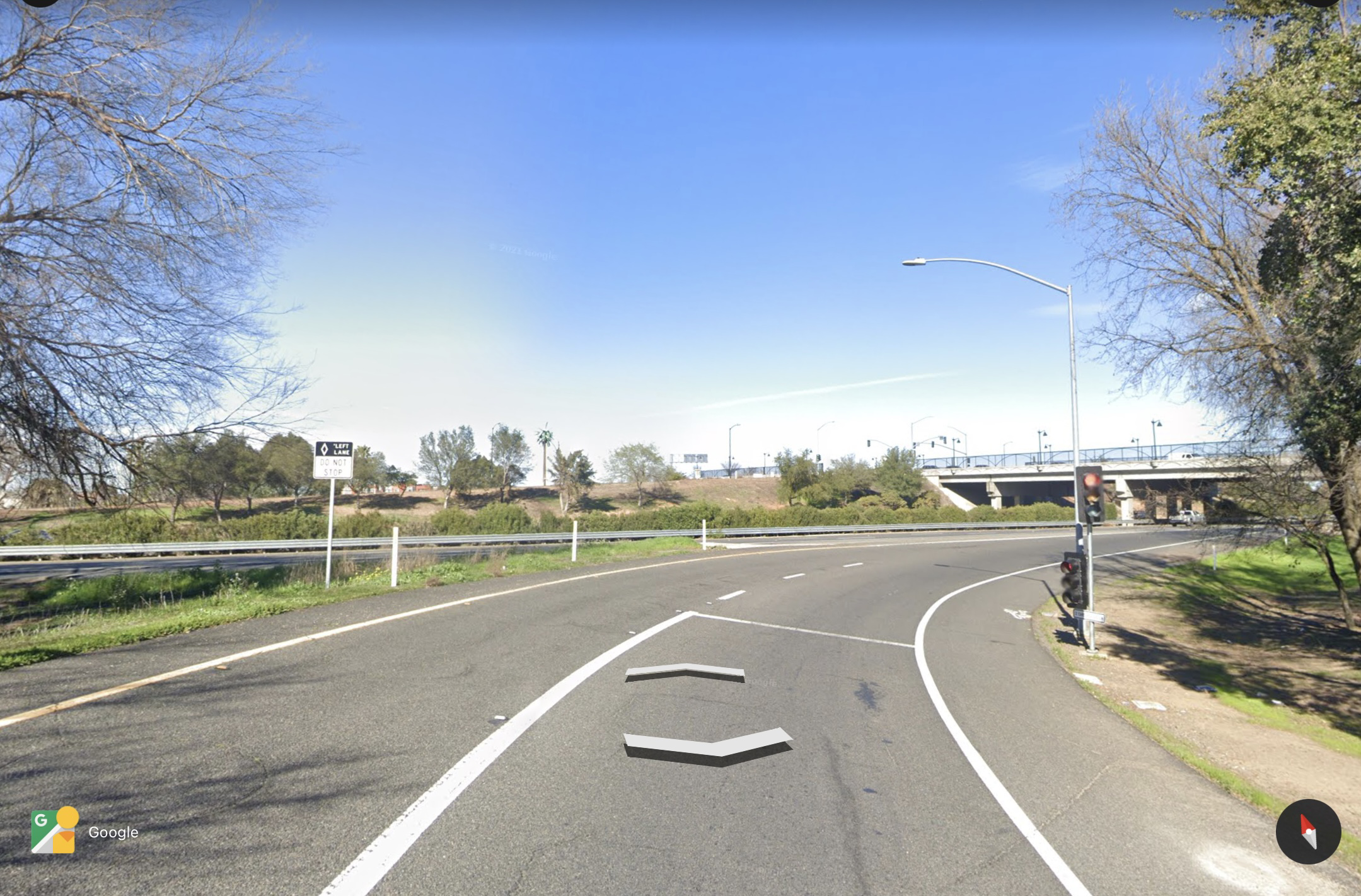
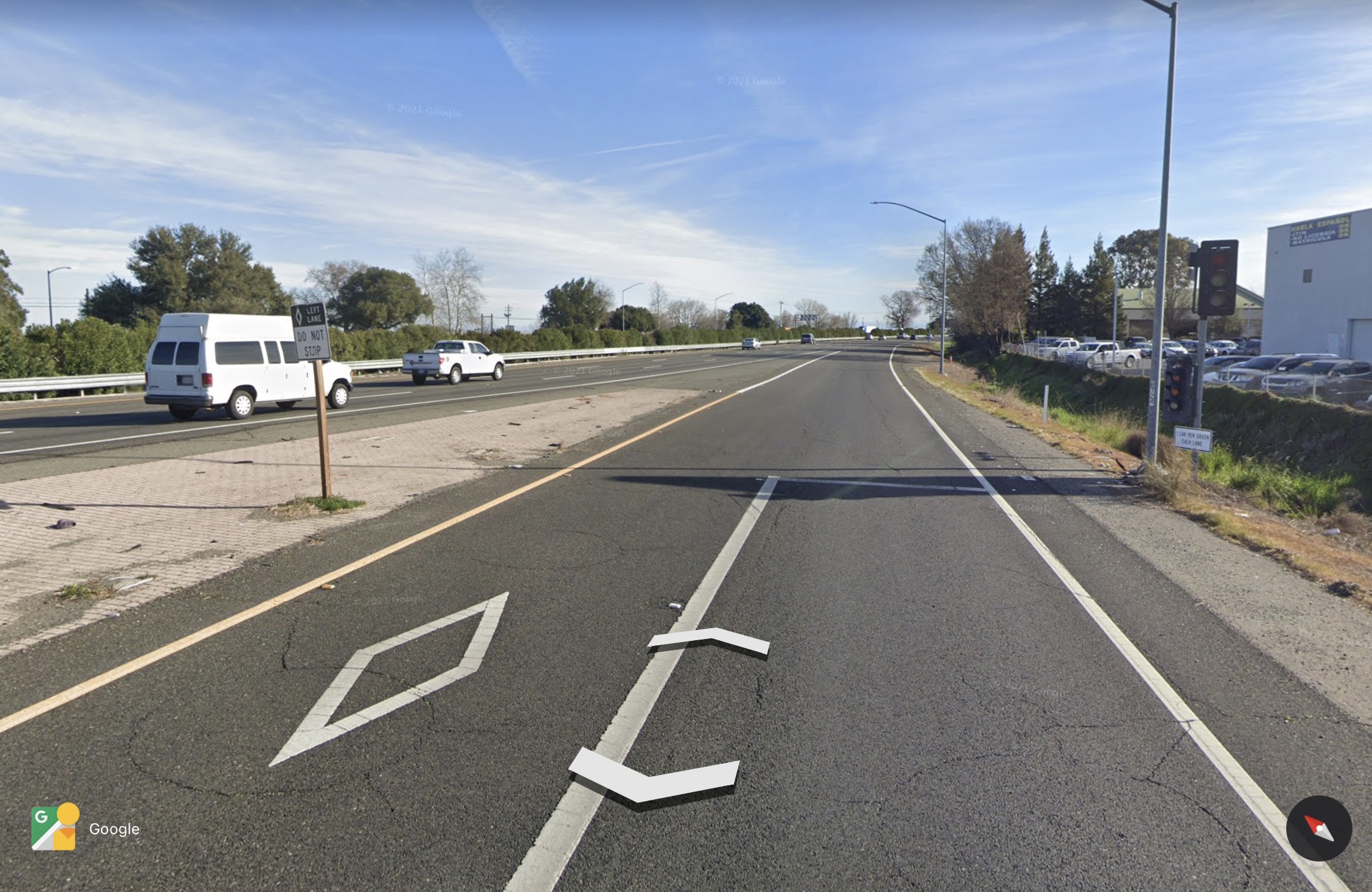
We need to keep them from winning. Hence, remove the carpool on-ramp lanes, as they create a shortcut for the first driver to achieve the best time that inspires the apps to direct hundreds of drivers to follow. Plus, Mace’s two on-ramps overwhelm the three-lane freeway.
Reducing that merging turbulence will speed up I-80, further decreasing the incentive for the apps to direct drivers to exit and drive through Davis.
There’s recent, local evidence that metered on-ramps reduce freeway delays. In 2018, Caltrans tested a meter on the Chiles on-ramp and found measurable speed improvement on I-80 after the Mace on-ramps. They made that ramp meter permanent. However, Caltrans has yet to meter the two Mace carpool on-ramps. Caltrans reports that 40% of the traffic at these on-ramps use the carpool lanes, much higher than legitimately expected, and hence we can expect a strong benefit from closing them.
If Caltrans insists on two lanes for each on-ramp, then both lanes need to be metered. That will take time and Caltrans asked Davis to pay for the $1 million cost. But that’s cheap compared to the cost of widening Mace. And to avoid creating an incentive for queue jumping, neither lane can be used for carpooling. So why have two lanes; just change the sign to allow two vehicles with each green. The logical first test is to close the carpool on-ramp lanes to determine if we can quickly and inexpensively improve the lives of Davis residents.
Conclusion
Before spending millions widening Mace to accommodate the freeway traffic, we need to try eliminating the incentive to exit the freeway and drive through Davis. Eliminating the three extra freeway lanes and closing the unmetered carpool on-ramps are quick and easy ways to keep drivers on the freeway. Do these changes synergistically tip the balance in the “game”? Let’s find out.
Peter Jacobsen lives in South Davis and is a registered Professional Civil Engineer




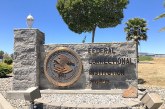
I’m not sure reducing lanes and the carpool lanes are answers. But I like your reasoning and think Caltrans should experiment with it (cones and barriers).
Can on ramp and off ramp metering and traffic lights be timed to slow down entering and exiting Davis during specific commute hours? Maybe in one way or the other that would dissuade freeway drivers from cutting through Davis?
I know it would never happen but a local toll for the on and off ramps in Davis would be cool. Residents would get passes that exempt them from the tolls. Regular commuters into the city of Davis…that have jobs here…could buy a monthly pass. Local stores could provide a code that acts like validated parking for people coming in to Davis to shop. Eh…just a crazy idea.
>> I’m not sure reducing lanes and the carpool lanes are answers. <<
To be clear, there is no real lane reduction being suggested here. Traffic generally flows great in the three consistent lanes between Vacaville and Davis. Right up until the “bubble” of lanes at the 113 interchange. The suggestion is to avoid adding all these gratuitous lanes in the first place because abruptly taking them away again creates the friction that ruins the laminar flow of the freeway and begins the cycle of drivers trying to find that quicker route. If the unneeded lanes aren’t added, they don’t need to be “reduced” later.
And the carpool aspect is only the metering light bypass of the onramps. This will result in taking away a benefit/encouragement to carpoolers for sure (do we even know it this has been effective??). But perhaps more important is that it removes an encouragement to cheat the system and stuff up the traffic for EVERYBODY.
What I have personally witnessed (either in a vehicle or watching the traffic apps in real time) countless times is that the “bubble” creates the initial friction that slows the freeway. The freeway flows well before the bubble and after the bubble. But because of the resultant slowing, some drivers exit at Tremont, fly down to Mace and then bypass the onramp queue by zooming through the unmetered carpool lane. The traffic apps quickly suggest this faster route to other drivers, and now all the metering light by-passers are stuffing up the freeway at Mace to slow it down back to the bubble. This becomes a circle of disaster for all roads that lead to the Mace onramps while the apps switch to taking the north route through town until that stuffs up, and then starts suggesting south of town again, etc.
Adding lanes in town to accommodate this freeway bypass traffic will serve to encourage more of it… not solve anything. And testing this “keep I-80 laminar” theory would be amazingly simple compared to spending ever more millions to make Mace a wider, more car-accommodating disaster. The problem needs to be fixed at the source. It cannot be fixed on local roads.
Never mind that we’ve lost sight completely of having this area be an integral part of our Safe Routes to School program.
Amen to that!
Maybe it’s not a city value anymore. Like how historic preservation, once written as key city value, is now overwhelmed (though only in vibe, not in writing) but the ‘need’ for infill housing. Similar here ‘fixing the mess’ has overwhelmed our values of safe routes to school and bicycle safety/mobility.
Not that crazy. Unprecedented as far as I know, but this might be the actual solution. It may not be possible to legislate away re-routes by apps (I suspect if it were it would have happened by now). However, scanner technology for FastTrak is universal now and used on express lanes as well as toll bridges. It would only take a single scanner at a choke-point on the reroute to scan FastTrak and have a camera for scanning license plates on cars without FastTrak (as is currently done with tolls). The traffic apps already warn of tolls, and the toll would only need to be implemented when Mace becomes clogged (which can be detected with a sensor as they do on freeways with FastTrak lanes). The toll amount will come up along with the time savings, giving drivers a choice, and the level set to the point that algorithms calculate will clear up Mace traffic, and only be turned on for those hours that pose a problem. (note: his could be seen as catering to rich drivers, i.e. anti-equity and there is justification in that, but that accusation has been leveled on ‘Lexus Lanes’ as well and they are being expanded statewide — so as long as those express lanes are still deemed “OK”, then this idea is as well.)
I believe you have actually come up with the solution, and I support this idea. Costs of installation and maintenance of course must be sought if and when this idea is to be considered.
I meant to add that as part of this, and exemption request should be available online for people with Davis or South Yolo addresses or can show they regularly traverse past the scanner for local or business purposes on a regular bases. I hope FastTrak software can accommodate this.
I thought that the city already decided to spend the money to fix what they previously created.
In regard to the photos of the lines of traffic on Second street (and at the intersection with Mace), I’d recommend a 2,000 plus parking space development at the end of that line of cars.
Along with Shriner’s, Palomino Place, the space inside of Mace Curve, and the “other half” of DiSC.
Or, you could just turn the street “upside down” (as in the first photo), and let gravity remove the cars.
Actually, like that comment…
But some believe, with some justification, that earth (and traffic thereon) has no gravity… it just sux…
I’m glad people are submitting ideas, as I believe the city’s solution, isn’t.
However, I’m not sure blocking lanes is any sort of solution, nor would Caltrans ever considered closing pavement. First, the Causeway is usually clogged past the point the lanes merge back together. This could not be caused by congestion further back in the system, so is not caused by the lanes merging. I also doubt merging is a cause of the congestion as something further downstream must be causing the slowing. As well, if this isn’t enough to cause the through times to decrease, WAZE will still route people on Tremont. I am also pretty sure some of those lanes are needed as the highway is configured so that people can get on/off at UCD. Rebuilding that configuration with fewer lanes could be expensive and problematic.
This is the second time its been suggested that carpool lane onramp skipping is so pervasive it is causing such a reduction in trip time that this is the cause that is producing more traffic on Mace due to WAZE reroutes. That might be true, but is only anecdotal so far. I’d sure be interested in a true count of carpool lane single occupant skippers as a starting point. It would seem to me this would have to be absolutely rampant to make a difference.
I don’t believe we should be building any infrastructure to accommodate what a traffic app does. This problem is so universal and such a problem that legislation is needed to ban certain routes from showing as through routes on traffic apps. We cannot have local city roads that were never meant for this clogged on a regular basis. As well, dangerous routes are sometimes chosen, such as the I-70 Colorado Vail Pass issue I previously cited.
Perhaps two hearty second amendment rights Davis residents could stand on each side of Mace on Friday evenings with rifles at their side for months on end until the message on their adjacent large sign is received by Bay Area tourists headed up I-80 for the weekend: “You are not welcome on this detour — Davis Traffic Militia (well regulated)”.
Thanks Alan.
That westbound I-80 also has a similar temporary additional lane, and suffers similar “mysterious” delays at peak use, shows adding and then taking away lanes creates congestion. In the westbound direction, the clog is in the middle of an agricultural area, and there’s no other explanation for it. Normally, a merge lane eases merging. But four miles of an extra lane (in both directions) encourages traffic to spread out. Hence, the merging involves a lot more cars, and therefore jams the freeway more than just an on-ramp lane.
There’s probably an optimum merge lane length; it’s not four miles.
Caltrans metering the Chiles (Fruit Stand) on-ramp shortened the slow-and-go length back to Mace. That’s good evidence that metering all the Mace on-ramp traffic will further shorten the congestion.
The forty percent of the Mace on-ramp traffic that uses the carpool lane is far higher than expected. But the point is that metering all the on-ramp traffic will improve freeway flow, and that will make staying on the freeway more attractive, and using Mace on-ramps less attractive, in a virtuous circle.
People should start accepting reality. Traffic is going to happen. Davis is on a major interstate. It is going to back up at times. People will try to cut through surface streets. Traffic will happen.
CR, that’s an insane finality to accpet. Traffic has been shown to be a huge contributor to air pollution; vehicles moving stop-and-go produce significantly more emissions. Even decades in the future when electric vehicles become over 50%, they still require more energy. Regardless, traffic is a complete waste of time to everybody in it, creating huge time loss to people on a massive scale, which also produces less time to sleep and do other things plus massive stress. Traffic should never be accepted, the consequences of traffic on society is a toll on multiple levels: air pollution, health, time loss, increased stress, reduced safety.
That I-80 flows with 3 lanes for the 23 miles from Vacaville to West Sacramento—except for 4 miles centered on the 113 interchange—shows removing the “bubble” will keep it flowing. The engineers call it laminar. Keep traffic streamlined and organized, and it moves. Disturb it, and it slows.
I love that this idea is getting coverage. I had a conversation with Darrell Dickey about his ideas about the “real” problems behind the mace mess on next-door several months ago, and the more I think about it, the more I think he is right.
I spent 8 years commuting out of town because there wasn’t commercial space for my company here in Davis, and as came home every day driving through town to my house off the mace exit, i noticed exactly what Darrel says: The traffic was fine on the 3-lanes of highway before davis, and it was fine at the 3 lanes of highway after the 113 junction… and at peak hours, it would back-up again at mace because of the other cars getting back on the freeway there.
This isnt a traffic story about people leaving town.. because there are no businesses on south mace to be a actual “source” of commuters filling those streets.. this is 100% a problem caused by people getting OFF the freeway to avoid the backup caused at what Darrell calls the bubble.
And it makes sense… I-80 goes from 3 lanes to SEVEN very quickly – and anyone who has driven through it has seen all the people getting out of the left lanes moving into the right-hand ones to try to get past the other traffic… only then having to merge back in moments later. That merging activity CREATES the backup… so if we remove the temptation to get out of lanes in the first place, the traffic will remain laminar all the way through.
But what I think is most exciting is how amazingly CHEAP it would be to fix the root problem here on 80. Or at least to test whether streamlining 80 will do the job.
The author suggests cones… but I think they are going to be bowled-over almost immediately. But portable jersey barriers are just as easy to move into place. And they dont need to be placed for very long of a distance. The difference in cost between trying that, and modifying mace again is going to be astounding. Even if it doesnt work, the experiment is worth the investment…
But that leaves another question: Does the city have any ability to influence the features present on i-80? How do we get this done? Who do we talk to?
Have these suggestions been presented to the traffic engineers who have been working on this problem for the last couple of years?
Don, South Mace was part of a Safe Routes to School project and was rebuilt with one lane in each direction (plus turn lanes), instead of two lanes. (With only a few vehicles a minute, one lane is plenty.)
As the historic Google Earth satellite images shows, it was clogged with two lanes before the project. I recall being caught in the traffic on a trip downtown. The left lane was clogged, and the guy in front of me wanted to get into the right lane. No one would let him in, and we sat through a couple cycles of the traffic signal before someone let him in. (After that episode, I would go south to drive anywhere.)
During project construction, the navigation apps stopped directing traffic to Mace. Once the construction finished, the apps resumed sending traffic to Mace. But people’s memory is short and folks blamed to project for the traffic.
Hence, I suspect the consultant was told to focus on the configuration of Mace. Instead, we need to understand why freeway traffic hammers it, and fix the underlying problems.
So the reason I asked is that your column, which is quite interesting, is coming in when the process is pretty far along. There have been plenty of public hearings, a lot of So. Davis and El Macero residents who have strong opinions about it, and city staff and the engineers probably feel pretty invested in the current plan at this point. Posting an article with a different perspective is interesting and perhaps helpful, but it seems that traffic professionals would already have considered the general thrust of your proposal and may have some reason they didn’t go in that direction. I wonder how the residents would feel about delaying the project further in order to pursue your suggestions. A discreet inquiry to the South Davis council member might be in order.
Don, I have been involved in this project for a long time. I have met with Supervisor Provenza. In 2020, I prepared a five-page-long technical memorandum for him, entitled “Reducing freeway bypass traffic on S. Mesa Blvd.” It included that satellite image, which shows that four lanes were jammed, and hence putting it back to four lanes will not eliminate the congestion. I shared that memorandum with then candidate Josh Chapman, requesting a meeting. Recently, I have asked for meeting with him and Lucas Frerichs. I received no response.
The project appears to be politically directed.
I have never heard any objections with this solution.
The public meetings were taken over by an angry mob. They were not effectively run, and were unproductive. I was personally accosted, which I reported to the police.
Experimenting with this solution does not delay the new project. Both can proceed simultaneously. The new project will need CEQA documentation and design, which will take a year. If this solution negates the demand for the new project, then it can be cancelled before significant money is spent.
At this point, the city is proposing to spend $5 million. That means good projects are not going to be built.
Don, that is an interesting, good and uncomfortable question.
Now that Peter has answered, I wanted to mention that your question seems to beg three more questions:
1. Do citizens have genuine access to the traffic engineers who have been working on this (beyond trying to bravely shout above the the folks who bring virtual torches and pitchforks to the “public engagement” meetings)? That seems to be a quaint concept.
2. Do the engineers have free-reign to design the best product? Or are they hobbled by requirements from council to appease the pitchfork crowd? Brett is famous for saying that Council should stop being Jr. Engineers and let the experts do their thing. But the city council has never stopped putting their own requirements and limits on the engineers, effectively preventing the final product from being the best it can be.
3. Davis can’t fix this by changing local roads. Will the city consider putting huge effort into dealing with Caltrans to solve the actual root of the problem? (So far I’ve been told no. That’s too hard to deal with Caltrans, and this is beyond the city’s scope.)
So it appears that City Council will pretend that this freeway bypass congestion can be solved by appeasing the vocal locals who want things “the way they were!” While we are often nostalgic about the past, I’m afraid that we can’t make Mace Great Again unless we address the actual problem. The traffic situation is not the same today as it was 10 years ago. So the same stroad isn’t going solve anything.
Years before the first version of this project was built some colleagues and I provided constructive input through official channels. Approximately 100% of it was ignored for the first iteration (beyond some checkbox items like protected bikeways and a two-lane street). The hours spent to inform for a second iteration have equally been ignored. The public meetings were a disaster as members of the public and council members were heckled and boo’d by the mob. My messages to city council over the years have been summarily ignored. And council continues to be unresponsive today. So while this may seem to be coming late… I have no idea how to get traction early.
Thank you, Darell and Peter, these are useful replies. Watching all this from some distance, it’s odd how visceral it all seems to be for some. But then, I was present at one of the great West Nile meltdowns. Seems to be the Davis style sometimes.
As to Darell’s questions,
— do citizens have genuine access? Evidently not, at least in the development phases of the projects. It seems that is what commissions are for, but the council is, of course, free to ignore most commissions as selectively as they choose.
— do engineers have free reign? Never, I’d guess. Aren’t there strings attached to the grants that funded this in the first place?
— as to dealing with CalTrans, I assume our assembly member and state senator have been brought into these discussions?
Here’s hoping Todd doesn’t actually want to put a tollbooth on the Solano County line.
Again: The city’s most relevant senior civil engineer position to deal with this matter has been vacant for almost five years. It was finally re-budgeted last summer and supposedly a hire is imminent or has just happened.
We know our city’s symbol – an anti-egalitarian anachronism that reached its heyday over thirty years before Davisville lost its third syllable. Imagine if this was our City’s symbol and we had no city attorney.
The great changes proposed herein should have great positive effects on peak congestion but less so on noise and other emissions. Higher speeds increase noise, also with EV’s. Tolls at highway gateways – principally structures over natural features such as Carquinez Strait and the Golden Gate – raise substantial income for public transport operations in the west side of the Northern California Megaregion that starts at the Solano County line. Why not for the Yolo Bypass?
The Great Narrowing needs to be complemented by other measures.
My analysis of this back and forth is that the city is trying to do what it CAN do… (with various stated inefficiencies) But they city does not have the influence or the jurisdiction to solve the REAL problem on I-80.
So my thought is… how do we get the people who have ACTUAL authority to weigh in on this potentially easy and impactful fix to DO SOMETHING.
We all know that anyone who works for CalTrans is not going to go out on a limb to proactively find a fix unless there is FIRE under their butts to do so.
So I might suggest two things:
1) Spread the word about this potential fix to as many davis-people as we can
2) Get those people to engage civicy to demand attention to the problem… lets bring the pitchforks to CALTRANS instead of City Hall….
Does that make sense?
Here’s what you do:
Hack into apps such as WAZE, and redirect freeway traffic into some alleyway in downtown Davis – with a pitchfork mob waiting for them.
And continue building 2,000 plus parking space developments outside of Davis.
Pretty sure I’ve seen/experienced some massive traffic jams – even where the lanes are already down to “3” (e.g., between Dixon and Vacaville, if I recall correctly).
The “3-lane” solution better hope that everyone is on their toes, and that they don’t get a flat tire, etc.
As far as “local tolls”, you’d better hope that the local governments don’t do-away with car registration enforcement.
“On the count of three, everyone hit the gas pedal. No excuses – don’t f this up.”
“Get off your damn phone, as well.”
“If everyone just cooperates, there’s (also) enough water for all the new Folsom, Elk Grove and Roseville residents passing through here.” 🙂
A great way to make happen a discussion about this issue is in the run up to and at the City Council-Bicycling, Transportation and Street Safety Commission (BTSSC) joint meeting at 530pm on April 5th, right before the main City Council meeting. Please write and leave a recorded comment for the City Council and copy the BTSSC any email. BTSSC’s new Chair and Commissioners are open-minded and keenly aware of many transport pitfalls, and have shown some signs they will advise the Council and not simply give staff the last word on things. They do need strong support from the public and what should be fixed, and how so. citycouncilmembers@cityofdavis.org btssc@cityofdavis.org + I would also copy nrc@cityofdavis.org
***
Indeed, why has the City’s de-facto transport-expert civil engineer – Fehr & Peers, because the City’s not had one for five years – not suggested anything related to this larger concept, even as they’ve studied modifications such as the second phase of stop lights on Mace and reacted like it was not a surprise about an idea I proposed years ago to toll people who drive through Davis too quickly on highways besides I-80, showing that they had no business here and were just Wazing?
Perhaps modifications like these brilliantly suggested by Peter Jacobson were outside their purview? Not clear on that, but what is clear is that the City’s lack of an senior level engineer for the last half of a decade has left questions and fixes like this out of the public and behind-closed doors discussion. And then also the senior planner who is now going to work for the Yolo County Transportation District apparently did not mention a fix like this during all of the Mace and I-80 Managed Lanes Project discussions, the latter of which is far from over yet headed towards more “loosening of the belt” – a metaphor for adding lanes to highways.
Does the City even have anyone qualified to respond to this? Well, they are supposedly hiring a new senior level engineer soon, who will sign their contract and step into the real doo doo at the heart of this Mess. Let’s welcome the new staff member with this challenge and give them the support to stand up to road gluttony and to whatever Caltrans has in their arsenal for resisting Jacobson’s regional sustainability concept. (By the way, the City is not even planning to hire a new senior planner until they see how things go with the new engineer. While there is overlap between engineering and planning in this area, there’s still a huge and continuing capacity deficit as a result.)
Bit O History — I-80 up until the early 70’s ran *under* the railroad tracks east of Mrak. You may notice it now runs *over* the tracks. It actually ran very near Putah Creek on campus, so it is now further east which allowed for all the new entrance buildings on the SE side of Putah now. When this section from the co-added Hwy. 113 interchange to just south of Richards was added along with the UCD Exit, the freeway was expanded to the six lanes in this section only. This was probably in anticipation of six lanes in each direction from San Francisco to Sacramento in some auto-induced hell-world nightmare from 70’s Caltrans planners.
I’m not convinced the merging is the main cause of the slowing, but there’s enough anecdotal evidence that I would be very interested in a study of this to see if reducing lanes has merit.
Before that the Pony Express ran near what is now UCD.
The good news, Davis’ transportation planner has resigned from the city staff. The bad news that same person got hired by Yolo County.
How do define “near”?
All referents I’ve ever heard of say that the Pony Express was St Louis, MO to Sacramento CA… not more… and lasted ~ 18 months… the land between Sacramento and Davis was marshland most of the year…
Davisville did not exist (much less UCD or Davis), when the Pony Express was ‘real’…
Check your “facts”…
And, thus, your “points”…
“The first Pony Express riders left from both ends of the route, St. Joseph, Mo. and San Francisco, on April 3, 1860. The westbound rider, upon arriving in Sacramento, boarded a steamer for San Francisco. The second rider arrived in Sacramento April 23 at 1 a.m. and had missed his boat. This being a Friday, the next steamer wasn’t scheduled until Monday. The rider, Sam Hamilton, set out along the stage trail from Sacramento to Benicia. This took him across the Yolo plank to ride in the tule swamp land to Putah Creek. Traveling at an average rate of 10 miles an hour, his first stop was at the Solano House. This was a stage stop located on the wagon road and was just across the Putah Creek, from what is present-day Davis and thus was in Solano County.
The next stop was Silveyville. In 1852, Elijah Silvey established this as way station, with a tavern and corral, for the mass of men headed for the gold fields. By 1860, Silveyville was a well established community with a store, saloon, school, two churches, blacksmith shop, and homes for the 160 residents.
From there Hamilton made his way to the village of Vacaville nestled in the Vaca Valley. He stopped at Gillespie’s store where he was given a fresh horse. E. F. Gillespie built his two-story wooden store in 1855 and by 1860 it served as a general merchandise store, post office and Wells Fargo & Co. office. At 4 a.m., when the Hamilton passed through, few of the settlers were there to greet him. Soon after he left, the people living on the fruit ranches would begin rising. And the local entrepreneurs would be headed for Main Street to their various businesses: livery stable, hotel, saloon, blacksmith and wagon making shop.
Now Hamilton flew on his new steed to the small settlement Rockville. By now the sun was up and the rider was passing by established farm homes and fruit orchards just finished budding, vineyards, grain fields and cattle grazing in pastures. At Rockville there was a proper stage depot, hotel, blacksmith and general store.
Now the rider took the pass through the hills to Benicia arriving at the famed Solano House at 7 a.m. The stage office for all parts of the state also was located on the premises of this hotel. The Solano Hotel & Livery Stable, with F.P. Weinmann as proprietor, was rated as a first-class hotel and was a recognized as the gathering place for visitors and locals alike. Benicia was a busy steamer port of call and ferry station. Here Hamilton was able to have his rest and Thomas J. Bedford, a local lad, took the mochila and continued the ride. Rider and horse boarded the ferry bound for Martinez. From there he would ride to Oakland and then board a ferry for his final destination, San Francisco.
In the months to follow, the riders would take 18 more trips through Solano County due to missing their connection with the steamer. Then in October of 1861, the telegraph wire met in Salt Lake City and the Pony Express was doomed. The last rider completed his ride in November.
Russell, Majors and Waddell overextended themselves in their Pony Express venture and went bankrupt. Missouri entrepreneur Ben Holladay bought the Central Overland, California, and Pikes Peak Express at public auction.”
https://articles.solanohistory.net/612/
I sit, corrected… thank you Ron G and Don S… sincerely… you checked your facts, and now my understanding, knowledge has been enhanced…
I appreciate that… for reals…
Near the Putah Creek Lodge there is a historical marker about the Pony Express bringing the mail from Sacramento to the Bay Area over land.
As said earlier, thank you for the correction… as a history nut (who came to the conclusion 50 years ago that would not likely be a good career move), I’d really like to know more about where that marker is… have never seen it, but want to…
As a 30-plus-years resident of South Davis, pre-metered Mace Hwy 80 East entrance and pre-widening of the three lanes to seven, I can certify that the traffic flow problems began right after those changes. After spending $3.5 millions to create a problem that was not, we are now looking at a $5 million expense that will leave some problems still unresolved.
I am in favor of Peter’s idea of studying some simple solutions. Let’s start by moving those red barriers from the corner of Mace and Cowell l 🤣and use them to temporarily block the second lane on the Mace ramp. It was a lot easier merging on the Hwy without the meter light as the cars built up some speed to merge, thus not requiring through traffic to abruptly switch lanes or briskly brake. We should also test reducing the seven lanes to no more than four lanes, but adding an exit only lane to Richards, just like there is one for Mace. And BTW, I’m not opposed to change when it makes life easier instead of harder. The Mace Mess has brought stress and aggravation to South Davis residents. The protected bike lanes aren’t getting more use from bicyclists and the sidewalks continue to be in disrepair and a danger to pedestrians.
Last, but not least, the elimination of the un impeded right turns at Mace and Cowell by the creation of those dangerous islands is another reason the traffic on Mace does not flow as well, and not just on Thursdays and Fridays.
The Pony Express – Davis – LocalWiki